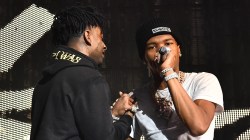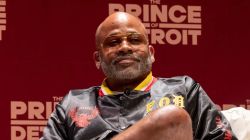To say that Cincinnati great white fathers have not learned anything since the 1968 riots that revealed scars behind Lady Bird Johnson’s auxiliary American Beautiful campaign for her presidential husband’s neo-New Deal Great Society program is understatement with implications farther reaching than Martin Luther King Jr.’s assassination and the recent gun slaying of an unarmed African-American male teen by a white policeman chasing him for outstanding traffic tickets.
Paralleling Los Angeles’ segregation with ethnic enclaves divided among terraces or plateaus rising as high as 900 ft. like a throne above the Ohio River to inspire its nickname of the Queen City, Cincinnati has been a paradox in egalitarianism since day one of its existence as a Yankee border town on the Mason-Dixon Line.
The town was named in 1788 for the Society of Cincinnati, a patriotic organization of American officers from the Revolutionary War. Like the Roman general and statesman Lucius Quinctius Cincinnatus their organization was named for, those aristocrats left their plows or slaves-run plantations to fight for freedom before oppressing the plebeian masses in their return to peacetime occupations.
Fugitive slaves swam or boated across the Ohio from Kentucky into Cincinnati toward freedom along the Underground Railroad. During the Civil War, black marketeers used the same natural highway for running Confederate goods and supplies back and forth from Cincinnati across the Union lines. Harriet Beecher Stowe gathered much of her material for Uncle Tom’s Cabin in Cincinnati, and Stephen Foster bit his most popular “darkie? tunes there. Cincinnati’s suburbs nurtured Doris Day before her shift from a swing chirp to antiseptic pop singer. They now are stronghold to the infectious glam rock period funk brought from the city to James Brown’s evolutionarily backing JB’s band and eventually to George Clinton’s Parliament Funkadelic sound before his Rubber Bandness became a band leader himself and founded the production company and do-it-yourself independent label Bootzilla.

AD LOADING...
The same Cincinnati that was the setting for the wacky but close-knit staff for mythical news and music radio station in the CBS television sitcom “WKRP? and that elected Jerry Springer as mayor (only to re-elect him after it was revealed that he wrote check to a hooker) also exhibited a puritanical zeal that made Hustler publisher Larry Flynt refugee with his porno based-empire, which now includes an African-American urban men’s magazine Code, to Beverly Hills, Calif.
Even at a time when racial lines are supposedly becoming blurred among younger generations of Cincinnatians since the -68 riots, the Queen City is known for a paradoxical rule in hip-hop. African-American scholars are lead researchers and teachers of hip-hop language and culture at Cincinnati’s colleges and universities. But when it comes to that innately afrocentric culture’s commercial control outside academe’s walls, Cincinnati’s lead urban magazines Strength and Skribble and its annual B-kid festival Skribble Jam are run primarily by white males.
To make better sense of Cincinnati’s Midwestern-southern bi-polarism, Nature Magazine talked with a post-baby boomer born during the Jimi Hendrix era, post-modern baby boomer born during the Sugarhill Records era, a cusp-baby boomer born during bebop’s World War II period”all with roots in the Queen City.
Donte Fleming, the post-modern baby boomer, is better known simply as Donte, one of the two African-American mic-controllers in the three-man rap group Mood (the other MC is Main-Flow, and the third member is the group’s white DJ, strawberry-dreadlocked Florida native Jahson). In its 1997-released Blunt Recording/TVT LP album Doom, Mood discussed the Queen City’s cultural paradoxes in “Cincinnati.?

AD LOADING...
Donte is also spiritual leader of the Ohio-based Wanna Battle crew that includes Mood, Cincinnati-based producer Hi-Tek, Talib Kweli and his collective Reflection Eternal. With Main-Flow’s relocation to San Diego, the multicultural crew spans both coasts and its Greater Cincinnati kinfolk either live or have lived on the Ohio and Kentucky sides of the region. Wanna Battle released the Landspeed-distributed compilation LP Ground Control: Prehistoric Sounds on the do-it-yourself indie Ground Control label Jahson has an interest in, and all members of the clan, like Donte, are recording individual projects on labels ranging from New York City-based major indie Rawkus Records to San Diego-based straight indie Greyboy Records.
Goldie-dreadlocked Chris Donnelley, the post-baby boomer, is an accomplished bass guitarist who moonlights as an account executive for a Cincinnati music distributor. Chris formed the post-modern Cincinnati funk band Shag, which toured the latter half of the 1990s and recorded two albums produced and released through Bootzilla on the do-it-yourself indie Solid. He spends a chuck of his free time volunteering at a Cincinnati homeless shelter.
Chris’ father Buddy Donnelley, the cusp-baby boomer, is a decorated Vietnam Conflict pilot living in St. Petersburg, Fla. His ancestral American roots are in Louisiana and Mississippi, and his immediate family moved to Cincinnati immediately after World War II from the Bayou State to “get the hell up out of the South.? He attended high school six blocks from legendary “race?-country label King Records, where James Brown recorded, and where his classmates were session players. Buddy has been a jack of many trades including many facets of the music business as promotions and is now a master print writer and Internet “mal-content? provider, and he intimately witnessed funk’s evolution from the Meters to Talking Heads.
THE CUSP-BABY BOOMER

AD LOADING...
Buddy Donnelley is a cusp-baby boomer because he was born toward the end of World War II and months before the post-war era characterized in vital statistics by a marked increase in the birth rate. His memories of growing up in Cincinnati during the 1950s include one of his friends’ mother abruptly changing the station to something more icky-friendly, or white-bread schmaltz, whenever rock -n roll blared up on the family car radio. One of his early jobs was with World Book Encyclopedia in Ohio’s state capital Columbus, where he screened prospective sales representatives by phone and turned away any applicants who sounded the slightest bit negro (the same practice occurred in the company’s Cincinnati office).
As the flaming liberal of his family, Buddy has gotten into more debates or arguments with barroom Darwins and Dixie-bred relatives on the insanity of Jim Crow, including the exclusion of minority contractors from the construction of Cincinnati’s publicly financed sports venues. Living, working, and bicycling around a retirement community on Florida’s East Coast has not kept him spiritually removed from the Midwestern border town where he came of age and reared his own family, although the battle between the Republican and Democrat presidential campaigns over the Florida election returns and electoral college votes has left him feeling a dissident in the southernmost banana republic on the North American mainland.
Buddy and a Floridian friend have dubbed the last Cincinnati riots triggered by the April 7 shooting death of 19-year old Timothy Thomas by a 29-year-old cop Stephen Roach the Fubu Riots because of the many images flashed over television of looters helping themselves to merchandise from some of Cincinnati’s most popular urban apparel retailers. Unlike many native white Cincinnatians of or near his generation, Buddy does not buy into the traditional law-and-order logic that Thomas invited the fatal gun shot by running from the police officer. Thomas was the 15th African-American suspect slain by Cincinnati police in six years.
“So he ran away,? Buddy says. “He was a kid. Kids do stupid things. You don’t kill him for that.?



